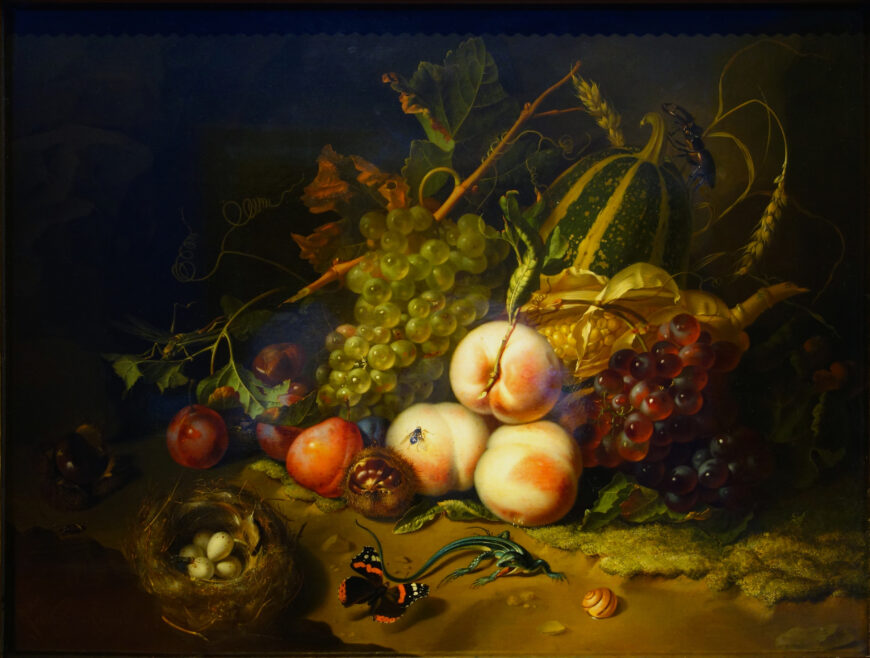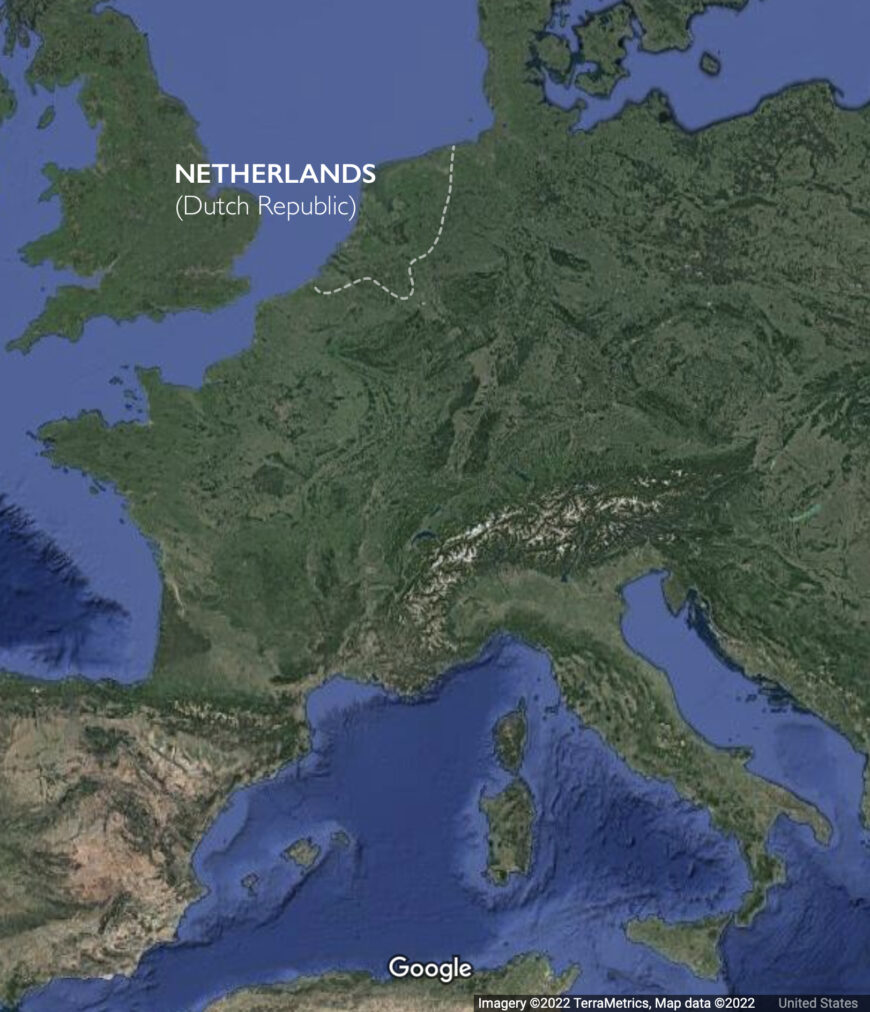No wonder Ruysch treats each element of this still life like a scientific specimen—her father preserved insects.
Rachel Ruysch, Fruit and Insects, 1711, oil on wood, 44 x 60 cm (Galleria degli Uffizi, Florence). Speakers: Dr. Steven Zucker and Dr. Beth Harris
Rachel Ruysch’s still life paintings are anything but still. A fly lands on a piece of fruit, a lizard scurries past, a butterfly pauses. An enormous stag beetle momentarily perches on top of a squash. Drips of condensation are about to run off the lush, firm grapes and onto the mossy, muddy ground. The painting vibrates with life and invites us to use all of our senses; to imagine the cool dark of a forest floor, the taste of the fruits, the sounds of a light breeze rustling the corn husks.
Still life painting
Still life paintings can be hard to know how to engage with because they seem so straightforward. In the Early Modern Period, it was sometimes even considered a lesser art, not requiring the ingenuity, the mathematics, or the anatomy that history paintings might require. What it did require was an intense mastery of observation, a curiosity about the natural world and the willingness to look at it slowly and carefully, the skill to arrange the elements into an engaging and harmonious composition, and the ability to reproduce in minute detail the fluttering, glistening surfaces of the subject matter.
While more philosophical artists in the Early Modern Period may not have thought much of still life, there is no evidence to support the idea that art buyers felt the same way. In fact, the painter of this work, the Dutch artist Rachel Ruysch, was sometimes paid as much as 1,200 gulden per painting. To put that in perspective, the painter Rembrandt was seldom paid more than 500 gulden per painting and yet it is Rembrandt who is today celebrated as the most important painter of his age. However, Rachel Ruysch was one of the highest paid artists during the late 17th and early 18th centuries and she supported her family with her earnings. She is also generally regarded as one of the best still life painters in the entire history of still life painting. Clearly, there was substantial interest in what she was creating.
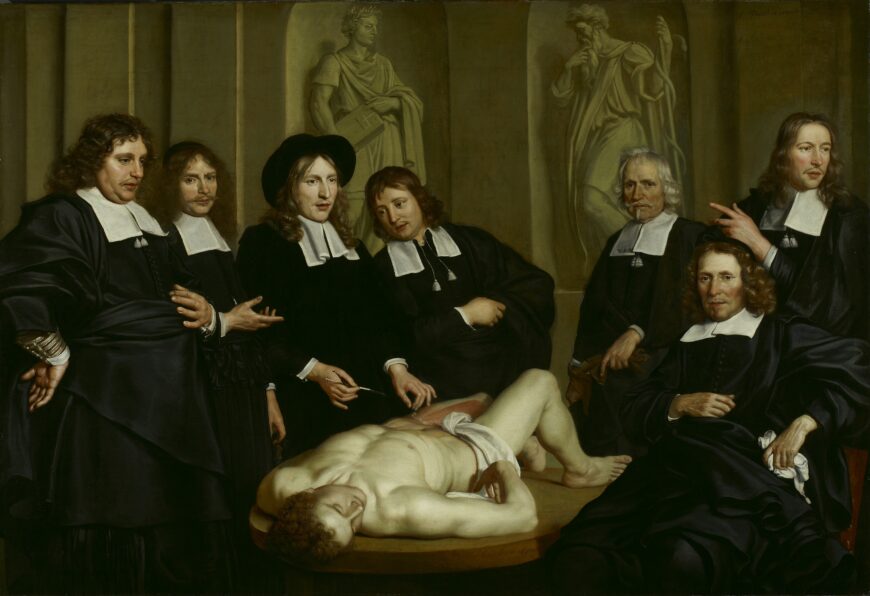
Adriaen Backer, Anatomy lesson from Dr. Frederik Ruysch, 1670, oil on canvas, 168 x 244 cm (Amsterdam Museum)
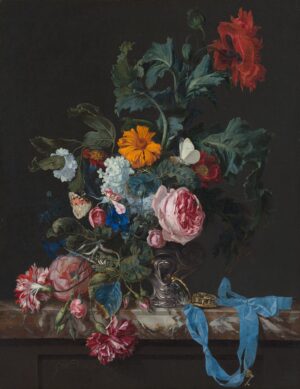
Willem van Aelst, Flower Still Life with a Timepiece, 1663, oil on canvas, 62.5 x 49 cm (Mauritshuis, The Hague)
Family and apprenticeship
The social networks surrounding Rachel help us understand both the content of her works and the social mechanisms that shaped her successful career. Born in 1664 in what is now The Netherlands, Ruysch grew up in Amsterdam in a household full of scientific curiosity and experimentation: her father Frederik Ruysch was an anatomist and natural scientist who developed techniques for preserving internal organs for scientific study. He was also one of the founders of the botanical gardens in Amsterdam and invented a technique to preserve flowers three-dimensionally instead of pressing them flat.
By the age of 15, Rachel was apprenticed to painter Willem van Aelst, a leading still life painter of the previous generation who had also worked in Italy and was known for his floral compositions. It was unusual for a young woman to have a formal apprenticeship with an artist and to train as a professional painter, but it was not unusual for them to learn to draw and paint. Rachel’s sister Anna also learned to paint (probably also from van Aelst), but instead of going on to be a professional, Anna painted as a hobby and helped run her husband’s paint business.
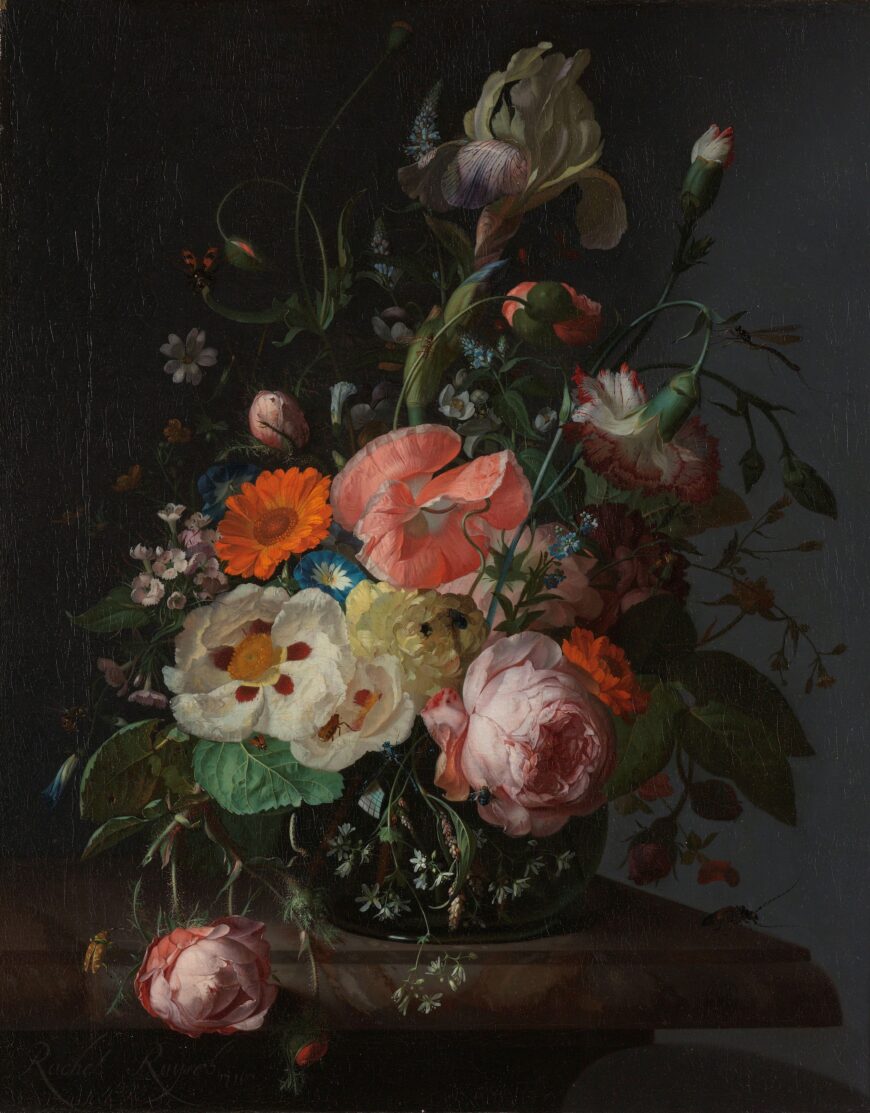
Rachel Ruysch, Still Life with Flowers on a Marble Tabletop, 1716, oil on canvas, 48.5 x 39.5 cm (Rijksmuseum, Amsterdam)
Not just copying nature
Many of Rachel’s works, such as Still Life with Flowers on a Marble Tabletop, like van Aelst’s, focus on a bouquet of flowers sitting on a stone ledge against a neutral background. Her signature can frequently be found along the front edge of the marble slab (in Still Life with Flowers on a Marble Tabletop, her signature is just visible on the lower left). The bouquets Rachel represents in her paintings never existed. Instead, they were composite images built up from studies and drawings to create a real-looking but imaginary array of different species that have been artistically composed. So even though artists who worked in other genres may have thought that still life was just “copying nature,” still life required compositional skills of arranging forms in engaging and dynamic ways to satisfy curious viewers.
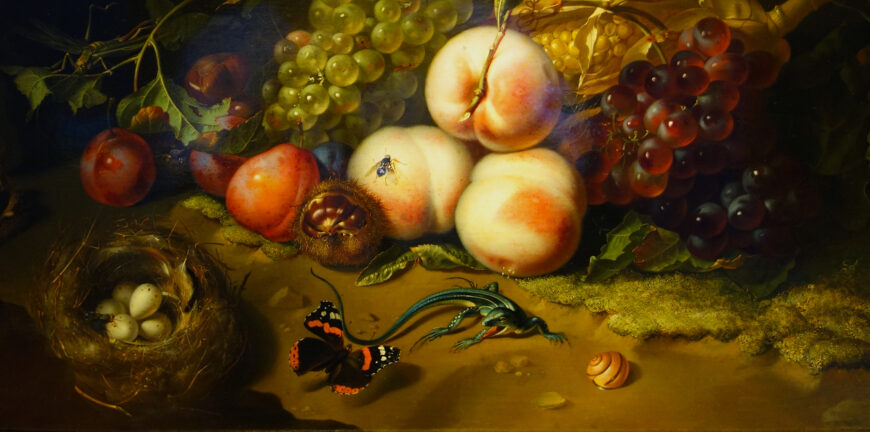
Fruit and creatures on mossy ground (detail), Rachel Ruysch, Fruit and Insects, 1711, oil on wood, 44 x 60 cm (Galleria degli Uffizi, Florence)
An important aspect of Fruit and Insects is the subject matter: it is not flowers in a vase on a ledge, the motif for which she was best known. Instead, this painting is a cluster of fruit and creatures on a mossy, muddy ground. This reflects Ruysch’s connection to another artistic tradition. Paintings of fruits, plants, and flowers with small creatures on the ground in a forest-like or natural space constituted a sub-genre of still life painting referred to as sotto bosco.
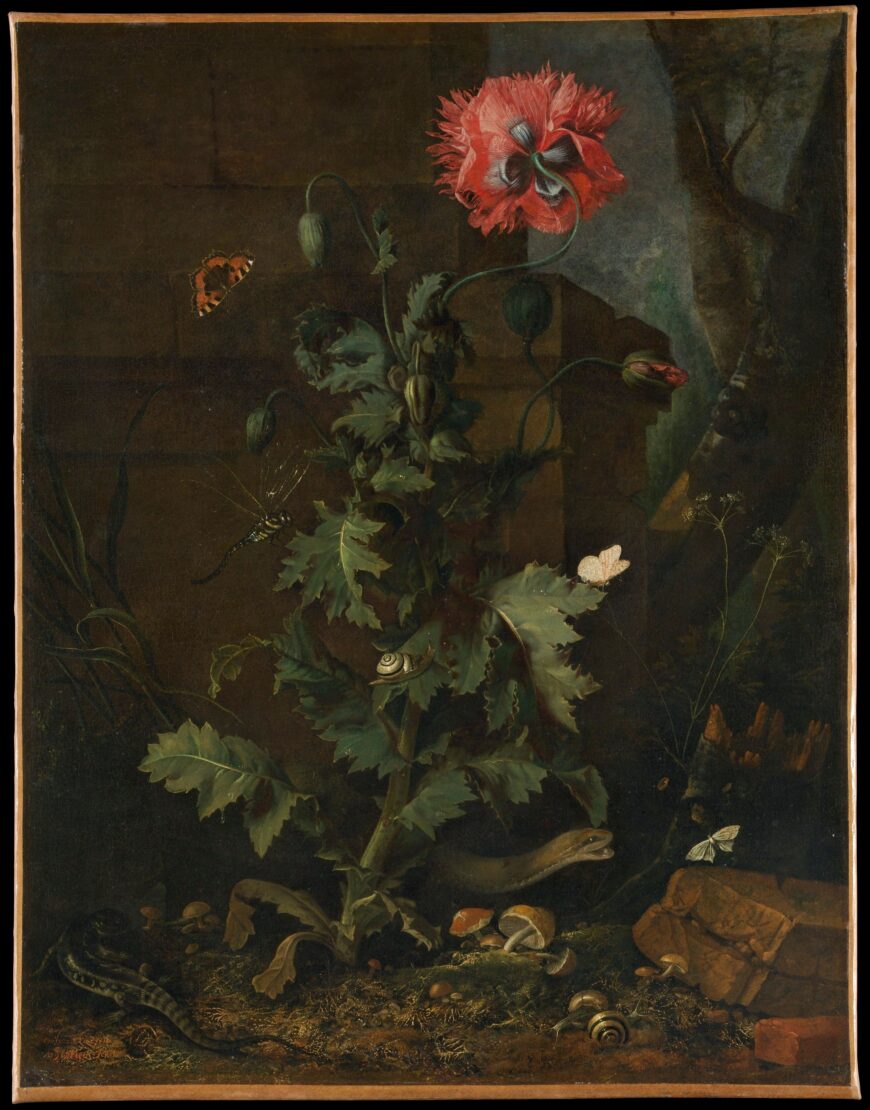
Otto Marseus van Schrieck, Still Life with Poppy, Insects, and Reptiles, c. 1670, oil on canvas, 68.3 x 52.7 cm (The Metropolitan Museum of Art, New York)
Sotto bosco was the signature style of fellow Dutch artist Otto Marseus van Schrieck, nicknamed “The Snuffler” for all the time he spent rooting around in the woods. He had been a friend and colleague of Willem van Aelst when van Aelst was working in Florence at the court of the Medici family. Ruysch was inspired by multiple aspects of Marseus van Schrieck’s work. Like him, Ruysch also used sponges to apply some of her paint and, like van Schrieck, she sometimes attached real moss and butterfly wings to the surfaces of paintings.
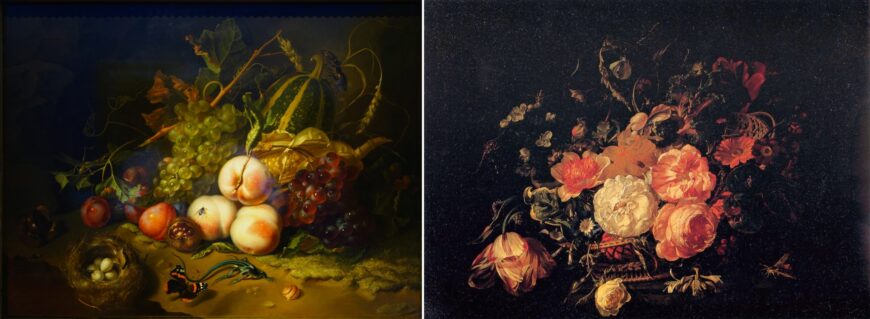
Left: Rachel Ruysch, Fruit and Insects, 1711, oil on wood, 44 x 60 cm (Galleria degli Uffizi, Florence); right: Rachel Ruysch, Basket of Flowers, 1711, oil on panel, 46 x 62 cm (Galleria degli Uffizi, Florence)
Part of a pair
Fruit and Insects was one of a pair commissioned by her main patron, Johann Wilhem, Elector Palatine of Bavaria. He commissioned these as a gift for his father-in-law, Cosimo III de’ Medici, Grand Duke of Tuscany (which is why the painting is in Florence today). The other painting in the pair was of a wicker basket filled with flowers, many of which bloom in spring such as narcissus and tulips. While the two paintings have some compositional similarities, they seem to reflect different seasons: the fruits and squash seem to suggest late summer into fall, while the basket of flowers suggest spring and early summer. Perhaps the two paintings were intended to be compared, to provide a chance to compare and contrast between the two seasons. They are strikingly different with regard to textures: the sotto bosco scene is full of objects with firm edges while the flowers feel soft, almost fluffy. The firmness of the squash create a satisfying counterpoint to the delicate scrolling stems and leaves of the flowers and the clusters of petals. Yet the paintings are compositionally similar, with the objects arranged into a rough pyramidal composition with a group of three round forms at the center as a focal point. In the “fall” painting, it is the three peaches; in “spring” the three large peony-like flowers.
If you look at a lot of paintings by Ruysch, you begin to notice that she repeats the motif of the three peaches throughout her body of work. You can imagine her preparing sketches of various plants, fruits, and creatures and endlessly recombining them to create new compositions for different patrons. In a way, this process is very similar to how her father studied anatomy, but it was also a common technique among artists: drawings made after live models, plants, and animals were a valuable tool for the artist.
Fame and regard
The fact that Rachel Ruysch lived in Amsterdam, had a major patron and supporter from the upper levels of society in what is now Germany, and had her paintings given to important figures like the Medici in Italy and purchased by the wealthy across Europe indicates her fame and the regard in which she was held during her lifetime. Poems were written about her and she was granted admission to the painter’s guild in the city of The Hague, the first woman to be allowed entrance. She lived into her 80s, and continued painting at the highest level her entire life. So even if still life hasn’t always been considered the most “important” kind of painting, it was a means by which a painter could build a reputation, achieve fame, make a substantial amount of money, and pursue their own creative and scientific curiosity, regardless of gender.

